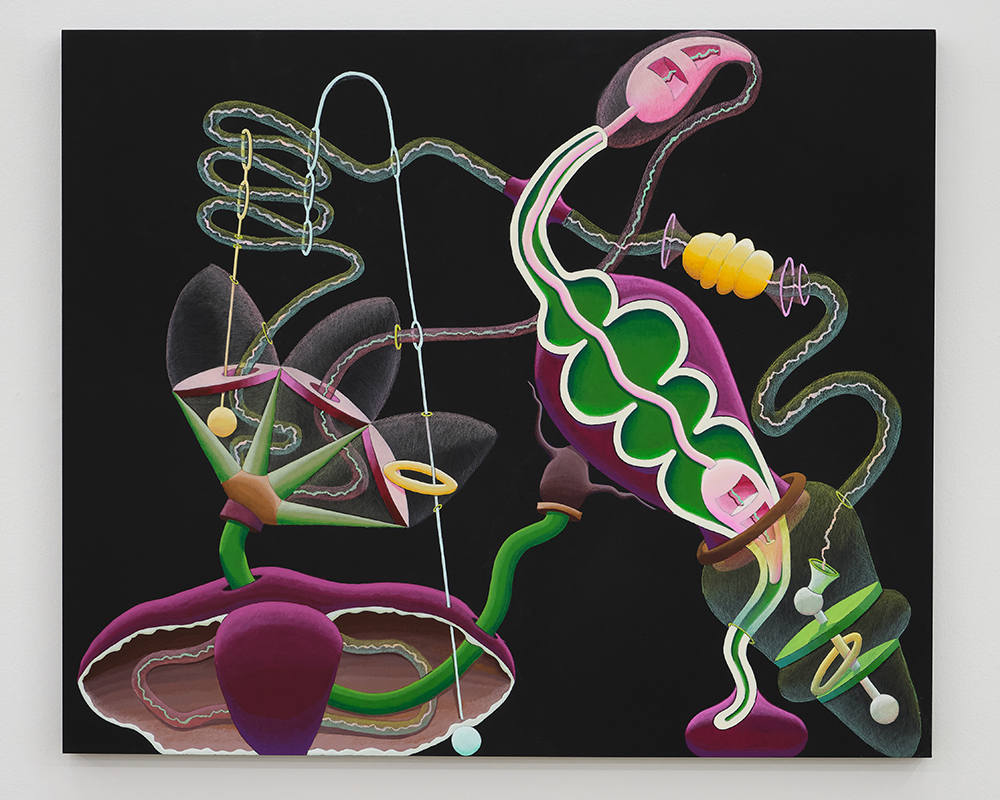If you’ve read any of Bernard Cooper’s books, you know about the care with which he constructs his sentences, how he gives each detail its own breathing room. (If not, Maps to Anywhere [1990] and his 2006 memoir The Bill from My Father are especially recommended.) Cooper has also been painting for 10 years now, and his debut exhibition, “An Insomniac’s Guide to the Night,” at Gattopardo suggests the public entrée of a doubly gifted rarity, along the lines of William Blake or Louise Brooks. A vivid, confident demonstration of contemporary American surrealism, the show proves that Cooper is not a writer who also paints but rather a consummate artist in the most expansive sense.
“An Insomniac’s Guide to the Night” was a super-saturated Rorschach test of an exhibition. Entering the gallery, the viewer encountered 16 jet-black birch panels against which mysterious and colorful “events” appeared to be taking place. The figures depicted—bright, bulbous shapes that suggest organic plant-life seen under a microscope in a mad scientist’s laboratory—connect in unpredictable ways; their mercurial progress across the canvas is echoed by the works’ physical formats, many of which diverge from the standard rectilinear frame to encompass additional, smaller canvases that serve as appendages or growths, suggesting a Rube Goldberg-like dream logic. The result was gloriously disorienting, a perfect balance between the enigmatic and the transparent, the forbidding and the inviting, the gnostic and the familiar. A Cooper painting takes the viewer up to a moment before its mystery is about to be revealed—and then suddenly vanishes into a charged black silence.

Bernard Cooper, At Midnight, 2022. Photo: Chris Hanke. Courtesy of the artist and Gattopardo.
Consider for example Amuse-bouche (2022), at 8 x 10 inches one of the smaller works included. Against the painting’s deep black ground, a green flask pushes a looped green stem up out of its mouth-like orifice. The stem is connected by a loop-ended crimson bungee cord-like form, and by a couple of wrinkly strings, to a Sherlock Holmes-esque pipe. The pipe’s bowl emits a cone of fuzzy light that relinks to the crimson bungee. It’s a still life in which nothing lies still, not even the identity of the objects. Cooper’s ability to render the uncanny visible speaks to his expertise as a draftsman—but even more so to the images’ refreshing lack of symbolic meaning. The artist allows these shapes to be themselves and do what they do; he never bullies his images into signifying X, Y or Z.
In his 1988 essay “How to Draw,” published in The Georgia Review, Cooper admitted, “I possess, against every cultivated judgment that came with my master’s degree, a preference for amateur art, for that which others often label ‘kitsch.’” But if we consider that amateur is derived from amor, we find him as endorsing a more sincere conviction in art than that espoused by “kitsch”—and instead, one that presupposes the artist as lover, whether of language or of shape and color. Cooper’s night shapes have been loved into being.


